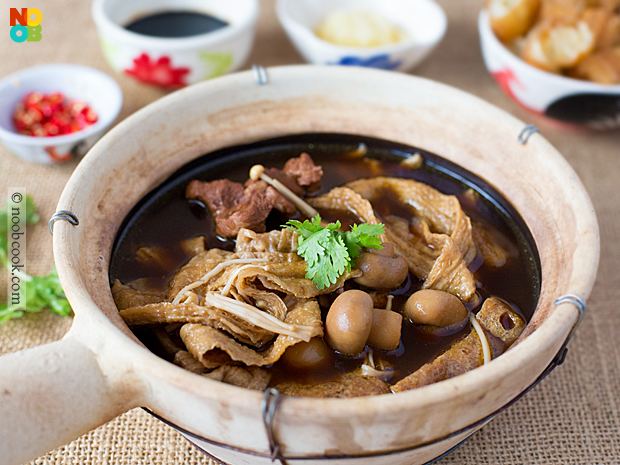 | ||
Region or state Main ingredients pork ribs, complex broth of herbs and spices (including star anise, cinnamon, cloves, dang gui, fennel seeds and garlic) Similar Laksa, Char kway teow, Hainanese chicken rice, Nasi lemak, Satay | ||
Bak kut teh in singapore boiled pork and tea
Bak-kut-teh (also spelt bah-kut-teh; Chinese: 肉骨茶; Pe̍h-ōe-jī: bah-kut-tê, Teochew dialect: nêg8-gug4-dê5) is a pork rib dish cooked in broth popularly served in Malaysia and Singapore, where there is a predominant Hoklo and Teochew community, and also in neighbouring areas like the Sumatra, Indonesia and Southern Thailand.
Contents
- Bak kut teh in singapore boiled pork and tea
- Bak kut teh recipe pork bone tea
- History
- Varieties
- National record
- References
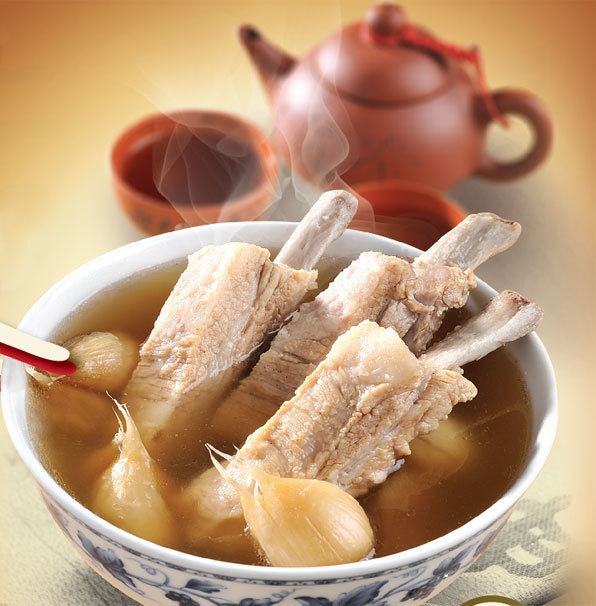
The name literally translates from hokkien(dialect) as "meat bone tea", and at its simplest, consists of meaty pork ribs simmered in a complex broth of herbs and spices (including star anise, cinnamon, cloves, dang gui, fennel seeds and garlic) for hours. Despite its name, there is in fact no tea in the dish itself; the name refers to a strong oolong Chinese tea which is usually served alongside the soup in the belief that it dilutes or dissolves the copious amount of fat consumed in this pork-laden dish.
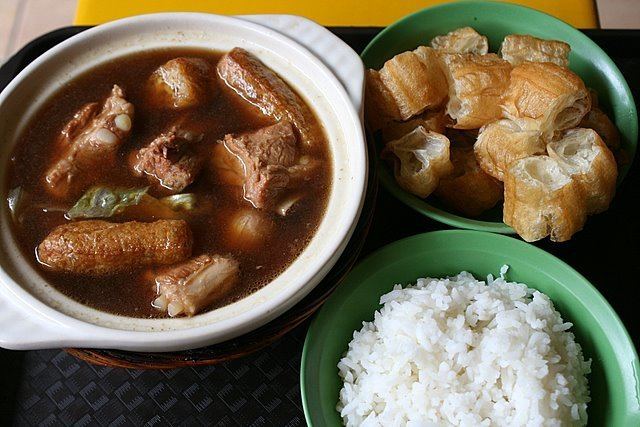
However, additional ingredients may include offal, varieties of mushroom, choy sum, and pieces of dried tofu or fried tofu puffs. Additional Chinese herbs may include yu zhu (玉竹, rhizome of Solomon's Seal) and ju zhi (buckthorn fruit), which give the soup a sweeter, slightly stronger flavor. Light and dark soy sauce are also added to the soup during cooking, with varying amounts depending on the variant - the Teochews version is lighter than the Hokkiens'. The dish can be garnished with chopped coriander or green onions and a sprinkling of fried shallots.
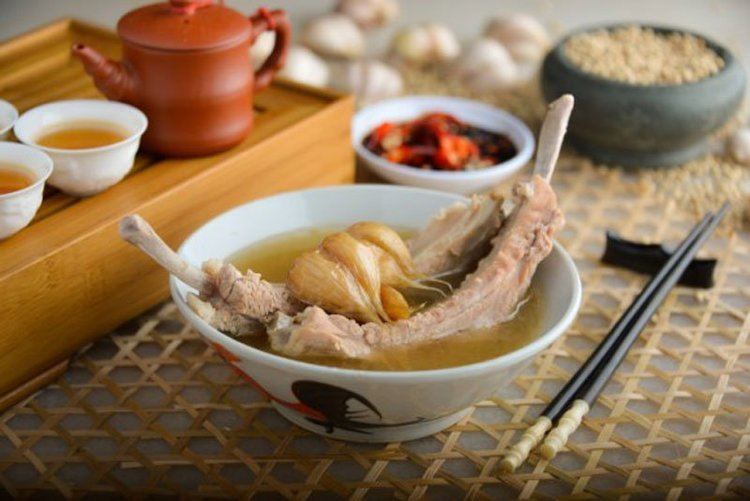
In Malaysia, it is often served with strips of fried dough called you char kueh (or 油條, 油条, youtiao, in Mandarin). Soy sauce (usually light soy sauce, but dark soy sauce is also offered sometimes) is preferred as a condiment, with which chopped chilli padi and minced garlic is taken together. Tea of various kinds, for example the Tieguanyin (鐵觀音, 铁观音) variety which is popular in the Klang Valley area of Malaysia, is also usually served in the belief that it dilutes or dissolves the copious amount of fat consumed in this pork-laden dish.Bak kut teh is typically eaten for breakfast, but may also be served as lunch. The Hokkien and Teochew are traditionally tea-drinking cultures and this aspect runs deep in their cuisines.
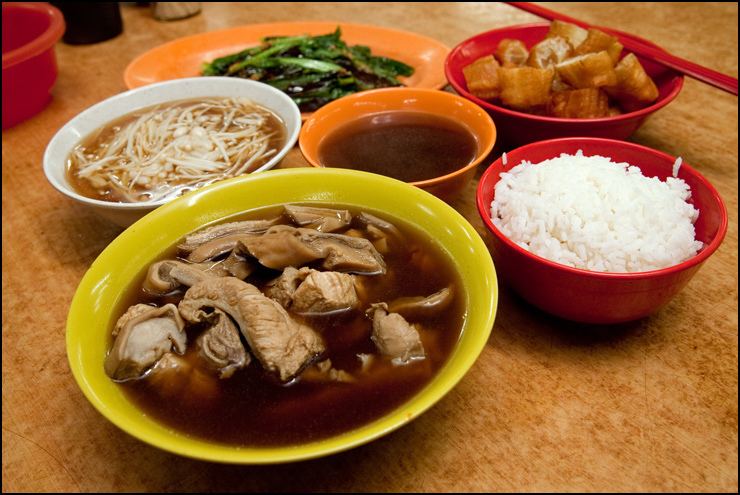
Bak kut teh recipe pork bone tea
History
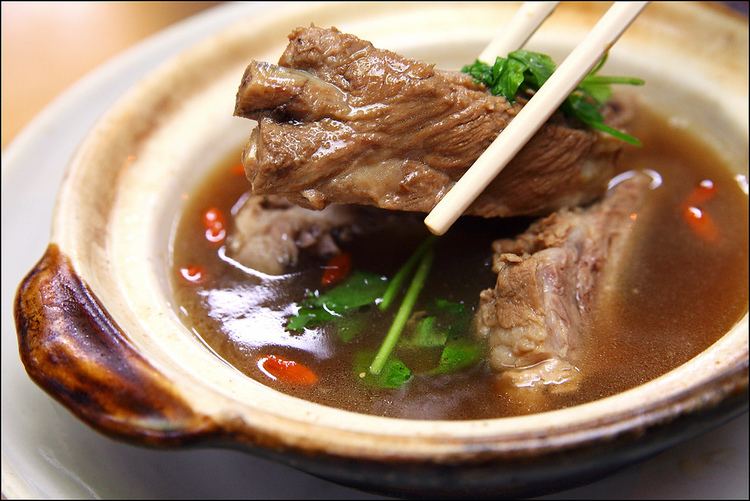
Bak-kut-teh is commonly consumed in both Malaysia and Singapore. The origin of Bak-kut-teh is unclear, but it is believed to have been brought over from Fujian, China. In Malaysia, the dish is popularly associated with Klang, and locals believed the place to be the origin of bak kut teh. There are a number of claims for the invention of the dish; one claimed that a local sinseh (a Chinese physician) invented the dish in the 1930s, while another claimed he brought the recipe from his hometown Fujian, China, in the 1940s. The dish is also claimed to have been invented in Port Klang for coolies working at the port to supplement their meagre diet and as a tonic to boost their health in the early 20th century. The dish was popular among early Chinese immigrants, many of whom had also come from Fujian.
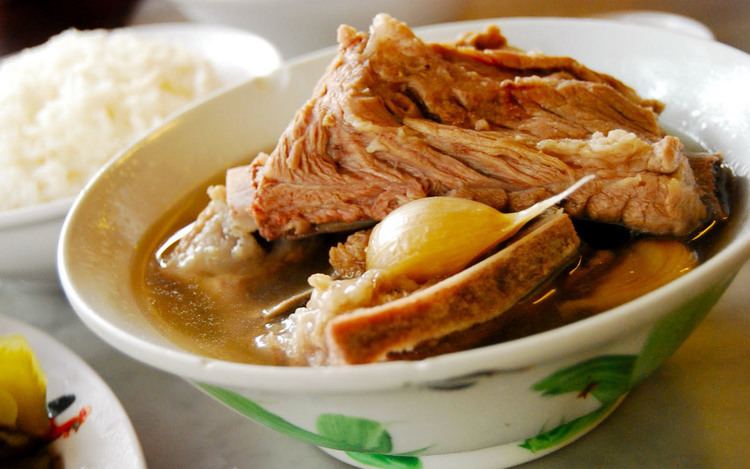
The Teochew variant was developed in Singapore and was sold in the Clarke Quay and River Valley areas after World War II. By the 1960s, bak kut teh had become a popular street fare in Singapore. Certain business has been focused mainly on serving this dish, and developed their business from humble pushcart into a restaurant chain.
The Chinese word bak (肉), which means "meat" (or more specifically pork), is the vernacular pronunciation in Hokkien, but not in Teochew (which pronounced it as nek), suggesting an original Hokkien root.
The question of its origin has been the subject of a dispute between Malaysia and Singapore; in 2009, the tourism minister of Malaysia, Ng Yen Yen, claimed that bak kut teh is a dish of Malaysian origin, and that neighbouring countries had "hijacked" many of Malaysia's original dishes.
Varieties
There are numerous variants of bak kut teh with its cooking style closely influenced by the prevailing Chinese enclave of a certain geographical location.
There are three types of Bak Kut Teh.
The main visual difference between the Hokkien and Teochew version of bak kut teh is that the Hokkiens use more dark soy sauce and thus the soup base is characteristically darker in colour.
In addition, a dry form of bak kut teh has also recently become increasingly popular within Malaysia, especially in Klang town. Although called dry, the broth is in fact reduced to a thicker gravy, to which other ingredients such as wolfberries, dried dates, dried chillies and dried squid are added. Unlike the original rib soup, the dry version has a tangier, sharper taste and is more akin to a herbal stew than the classical broth. It is often recommended locally in Malaysia as an excellent hangover cure.
In Malaysia, a less fatty variation of bak kut teh made with chicken instead of pork is called chik kut teh. It also serves as a halal version of the dish catered to Muslims, whose religion forbids them to consume pork.
Vegetarian bak kut teh also can be found in Malaysia. Instead of using pork or chicken, oyster mushroom is used.
National record
On Nov. 22 2008,the Malaysian Klang Chinese Chamber of Commerce and Industry (KCCCI) had collaborated with five Bak Kut Teh (meat bone tea) sellers in Klang to cook the world's biggest bowl of Bak Kut Teh. The bowl of Bak Kut Teh with 182.88 cm in diameter and 91.44 cm in height, and containing 500 kg of pork, 450 kg of soup and 50 kg of herbal medicine, has been listed in the Malaysian Book of Record.
